[Download more information] [Download course registration]
The science of geomechanics – the evaluation of the interplay between stress, pressure, mechanical properties and strength in rock and soil – has become a critical, go-to technology in the characterization and engineering of Unconventionals Plays. But why has geomechanics become so important for Unconventionals? Equally important, how is the non-expert supposed to make sense of the confusion, gaps, and controversial opinions on the application of geomechanics to Unconventionals?

The focus of this course is geomechanics and its importance to Unconventionals – specifically, the role of stress, pore pressure, temperature, and mechanical properties in petroleum operations and, in particular, tight and shale gas/oil hydraulic fracturing operations.
The fundamentals of oil field geomechanics, along with a review of common geomechanics applications (both near-wellbore and reservoir geomechanics), will first be covered. Then, the second part of the course will be devoted to hydraulic fracturing for unconventional resources (hydraulic fracturing in naturally fractured reservoirs) with an emphasis on the geomechanics, modeling and field aspects of shale gas/oil drilling and completions. The common geomechanical issues for Unconventionals (i.e., brittleness, complexity, SRV, etc.) will be addressed, and the course will then conclude with a review of the important geomechanical aspects of the characterization and engineering optimization processes (i.e., stage spacing, landing location, etc.) in Unconventionals.
The course is offered in both a 3-day and a 5-day version. The 5-day course contains more exercises and more in-depth discussion on several topics (primarily geomechanics fundamentals).
About The Instructors
The primary instructor for the course will be Dr. Neal Nagel. Dr. Nagel has 26+ years of industry experience and has provided geomechanics consulting since 2009 and geomechanics training since the late 80s. He is a well-known expert in the geomechanics of Unconventionals and has given many invited SPE, AAPG, HGS, SEG, and SPWLA presentations in the last several years. Nagel has also authored or coauthored more than 20 technical papers related to Unconventionals, including a keynote presentation at the 2014 SPE Hydraulic Fracturing Technical Conference. He is a past SPE Distinguished Lecturer (2004) and was chief editor of the 2010 SPE Monograph on Solids Injection.
The second instructor will be Dr. Marisela Sanchez-Nagel. Dr. Sanchez-Nagel has more than 21 years of industry experience both with a major oil company (PDVSA) and as a consultant. She was a 2013 SPE Distinguished Lecturer on Unconventional Geomechanics and has also given numerous invited presentations on Unconventionals (SPE and SPWLA). Sanchez-Nagel has extensive global geomechanics experience, with a particular emphasis on Latin and South America where she has taught numerous geomechanics courses (often in Spanish). She is active in SPE and the American Rock Mechanics Association (ARMA).
Course Content
A broad outline of the course consists of:
Part 1. GEOMECHANICS FOR PETROLEUM APPLICATIONS (2-Days)
- Principles of Stress and Strain
Basics of stress/strain and Mohr circles; Effective stress concepts and the importance of pore pressure; Stress field variations and structural effects; and Stress measurements and analysis; examples and exercises
- Pore Pressure Evaluation and Estimation
Basic concepts and causes of over pressure; Analysis concepts: NCT, Bowers, Centroid-Effect; and Analysis workflow, examples, and exercises
- Mechanical Rock Behavior
Mechanical properties (elasticity and other stress-strain behavior); failure and beyond; Influence of faults and fractures; Laboratory vs. log vs. field data; and Examples and exercises
- Geomechanical Modeling and Workflow
Concepts and tools; 1D/2D modeling and 3D modeling; 4D modeling (dynamic vs static geomechanics); and Example geomechanics workflow
- Review of Common Petroleum Geomechanics Applications
Wellbore stability; Completions (sanding); Solids (cuttings) injection; Monitoring/testing (4D seismic, FIT/LOT/XLOT)
Part 2. GEOMECHANICS FOR UNCONVENTIONAL APPLICATIONS (3-Days)
- Introduction to Unconventional Developments
On the importance of Unconventionals world-wide; common play characteristics; and Challenges in general and challenges from a geomechanics point-of-view
- Hydraulic Fracturing–Basics and Conventional Modeling
Basics; models and design; frac QC; Conventional models in unconventional developments; and Workflow and examples
- Naturally Fractured Reservoirs (NFRs)
Concepts, characterization, and modeling – Discrete Fracture Network (DFN) issues; NFR behavior and influence on: drilling, stimulation, and production; and Workflow and examples
- Microseismicity
Interpretation and modeling; and Use of numerical models for interpretation and characterization
- Unconventional Reservoir Quality Evaluations
Basic concepts; and TOC, porosity/permeability, natural fractures, pressure, stresses and mechanical properties as quality indicators
- Shale and Shale-Like Properties and Behavior
What is shale? Shale properties; and Shale types; ‘Brittle’ vs. ductile behavior; and Shale like behavior – Is coal an important analog?
- Unconventional Completions: Critical Geomechanical Aspects
Geomechanics of shale plays; modeling and shale completions; Stress shadows, stage spacing, stress rotations, and SRV; Landing location and perforation strategies; Workflow and key issues from published work and numerical simulations; and Bakken, Haynesville, Marcellus, Eagle Ford, examples
Click for more information and to register today.

 NSI Technologies
NSI Technologies GEOPROCESADOS
GEOPROCESADOS